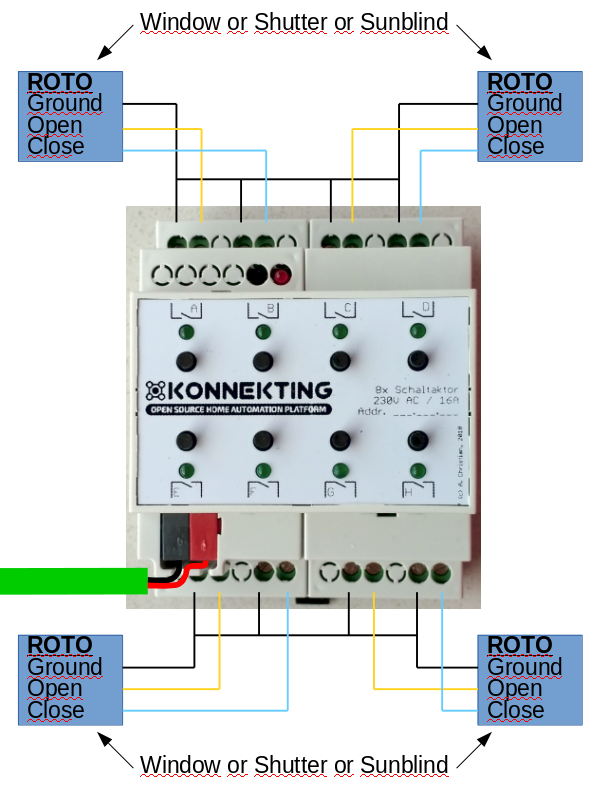Difference between revisions of "DFF4.1 User Manual"
Konnekting (talk | contribs) |
Konnekting (talk | contribs) |
||
| Line 29: | Line 29: | ||
=== Structure and Handling === | === Structure and Handling === | ||
| − | The exemplary circuit diagrams shows the structure of the device. Albeit the device obviously has 8 outputs (A..H), it has 4 channels. | + | The exemplary circuit diagrams shows the structure of the device. Albeit the device obviously has 8 outputs (A..H) and the cover says "8x Schaltaktor", it has - with the intended firmware - only 4 channels. |
* channel A+B | * channel A+B | ||
| Line 36: | Line 36: | ||
* channel G+H | * channel G+H | ||
| − | Every channel can control either a window, a shutter or the optional sunblind. Every channel has two buttons and two LEDs. Every button and LED is assigned to one output. The first one (f.i. for "channel A+B" this will be A) is for an open-operation and the second one (=B) is for a close-operation. | + | Every channel can control either a window, a shutter or the optional sunblind. Every channel has two buttons and two LEDs. Every button and LED is assigned to one output. The first one (f.i. for "channel A+B" this will be A) is for an open-operation and the second one (=B) is for a close-operation. Every channel can be manually controlled by their buttons directly at the device. The LED visualize the current status of move-operation. |
| − | For programming the device for the first time and for programming the physical address, the programming button must be pressed | + | For programming the device for the first time and for programming the physical address, the programming button must be pressed. |
| − | An active programming mode is shown by the red LED next to the programming button. | + | An active programming mode is shown by the red LED next to the programming button. |
=== Functions === | === Functions === | ||
Revision as of 06:30, 17 May 2018
DFF4.1 User Manual
This is the user manual for the KONNEKTING DFF4.1 Roto Rototronic roof window actuator. Please read it carefully.
Disclaimer
Both the observance of this manual and the application of the construction manual for this kit, as well as the installation, operation, use and maintenance of the resulting device can not be supervised by the DIY kit creator. The DIY kit creator therefore assumes no responsibility and liability for losses, damages or costs resulting from faulty installation and improper operation. So any use of this DIY kit is at your own risk.
Overview
Intended use
This DIY kit is intended to build a device that is used to control a ROTO Rototronic electrical skylight (roof window).
Supported Devices
The manual refers to the following devices kit constellation:
- Application PCBDFF4.1 rev1.0 and rev1.1
- Controller M0dularisM+ rev1.0 and rev1.1
- Frontend Top8LedButton rev1.0 and rev1.1
Exemplary circuit diagrams
Structure and Handling
The exemplary circuit diagrams shows the structure of the device. Albeit the device obviously has 8 outputs (A..H) and the cover says "8x Schaltaktor", it has - with the intended firmware - only 4 channels.
- channel A+B
- channel C+D
- channel E+F
- channel G+H
Every channel can control either a window, a shutter or the optional sunblind. Every channel has two buttons and two LEDs. Every button and LED is assigned to one output. The first one (f.i. for "channel A+B" this will be A) is for an open-operation and the second one (=B) is for a close-operation. Every channel can be manually controlled by their buttons directly at the device. The LED visualize the current status of move-operation.
For programming the device for the first time and for programming the physical address, the programming button must be pressed. An active programming mode is shown by the red LED next to the programming button.
Functions
TODO
Settings
TODO
Starting up
When the device gets powered, it will bring the configured channels to a default position. For channel type "window", the connected window is closed. For all other types, the connected shutter or sunblind will open.
Communication Objects
TODO
General
TODO
Channel specific
TODO
Parameters
TODO
General
TODO
Channel Specific
TODO
